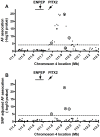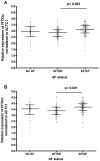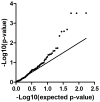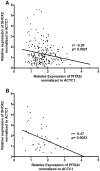Atrial Fibrillation associated chromosome 4q25 variants are not associated with PITX2c expression in human adult left atrial appendages
- PMID: 24465984
- PMCID: PMC3899225
- DOI: 10.1371/journal.pone.0086245
Atrial Fibrillation associated chromosome 4q25 variants are not associated with PITX2c expression in human adult left atrial appendages
Abstract
Atrial Fibrillation (AF), the most common sustained arrhythmia, has a strong genetic component, but the mechanism by which common genetic variants lead to increased AF susceptibility is unknown. Genome-wide association studies (GWAS) have identified that the single nucleotide polymorphisms (SNPs) most strongly associated with AF are located on chromosome 4q25 in an intergenic region distal to the PITX2 gene. Our objective was to determine whether the AF-associated SNPs on chromosome 4q25 were associated with PITX2c expression in adult human left atrial appendages. Analysis of a lone AF GWAS identified four independent AF risk SNPs at chromosome 4q25. Human adult left atrial appendage tissue was obtained from 239 subjects of European Ancestry and used for SNP analysis of genomic DNA and determination of PITX2c RNA expression levels by quantitative PCR. Subjects were divided into three groups based on their history of AF and pre-operative rhythm. AF rhythm subjects had higher PITX2c expression than those with history of AF but in sinus rhythm. PITX2c expression was not associated with the AF risk SNPs in human adult left atrial appendages in all subjects combined or in each of the three subgroups. However, we identified seven SNPs modestly associated with PITX2c expression located in the introns of the ENPEP gene, ∼54 kb proximal to PITX2. PITX2c expression in human adult left atrial appendages is not associated with the chromosome 4q25 AF risk SNPs; thus, the mechanism by which these SNPs are associated with AF remains enigmatic.
Conflict of interest statement
Figures






Similar articles
-
PANCR, the PITX2 Adjacent Noncoding RNA, Is Expressed in Human Left Atria and Regulates PITX2c Expression.Circ Arrhythm Electrophysiol. 2016 Jan;9(1):e003197. doi: 10.1161/CIRCEP.115.003197. Circ Arrhythm Electrophysiol. 2016. PMID: 26783232 Free PMC article.
-
Genetic variants associated with risk of atrial fibrillation regulate expression of PITX2, CAV1, MYOZ1, C9orf3 and FANCC.J Mol Cell Cardiol. 2015 Aug;85:207-14. doi: 10.1016/j.yjmcc.2015.06.005. Epub 2015 Jun 11. J Mol Cell Cardiol. 2015. PMID: 26073630
-
Long-range Pitx2c enhancer-promoter interactions prevent predisposition to atrial fibrillation.Proc Natl Acad Sci U S A. 2019 Nov 5;116(45):22692-22698. doi: 10.1073/pnas.1907418116. Epub 2019 Oct 21. Proc Natl Acad Sci U S A. 2019. PMID: 31636200 Free PMC article.
-
PITX2-dependent gene regulation in atrial fibrillation and rhythm control.J Physiol. 2017 Jun 15;595(12):4019-4026. doi: 10.1113/JP273123. Epub 2017 Apr 25. J Physiol. 2017. PMID: 28217939 Free PMC article. Review.
-
Understanding PITX2-Dependent Atrial Fibrillation Mechanisms through Computational Models.Int J Mol Sci. 2021 Jul 19;22(14):7681. doi: 10.3390/ijms22147681. Int J Mol Sci. 2021. PMID: 34299303 Free PMC article. Review.
Cited by
-
The role of transcription factors in atrial fibrillation.J Thorac Dis. 2015 Feb;7(2):152-8. doi: 10.3978/j.issn.2072-1439.2015.01.21. J Thorac Dis. 2015. PMID: 25713730 Free PMC article. Review.
-
PITX2 upregulation increases the risk of chronic atrial fibrillation in a dose-dependent manner by modulating IKs and ICaL -insights from human atrial modelling.Ann Transl Med. 2020 Mar;8(5):191. doi: 10.21037/atm.2020.01.90. Ann Transl Med. 2020. PMID: 32309338 Free PMC article.
-
Mechanisms underlying pro-arrhythmic abnormalities arising from Pitx2-induced electrical remodelling: an in silico intersubject variability study.Ann Transl Med. 2021 Jan;9(2):106. doi: 10.21037/atm-20-5660. Ann Transl Med. 2021. PMID: 33569408 Free PMC article.
-
Genetic and Molecular Underpinnings of Atrial Fibrillation.NPJ Cardiovasc Health. 2024;1:35. doi: 10.1038/s44325-024-00035-5. Epub 2024 Dec 4. NPJ Cardiovasc Health. 2024. PMID: 39867228 Free PMC article.
-
A Functional Variant Associated with Atrial Fibrillation Regulates PITX2c Expression through TFAP2a.Am J Hum Genet. 2016 Dec 1;99(6):1281-1291. doi: 10.1016/j.ajhg.2016.10.001. Epub 2016 Nov 17. Am J Hum Genet. 2016. PMID: 27866707 Free PMC article.
References
-
- Lloyd-Jones DM, Wang TJ, Leip EP, Larson MG, Levy D, et al. (2004) Lifetime risk for development of atrial fibrillation: The framingham heart study. Circulation 110: 1042–1046. - PubMed
-
- Gudbjartsson DF, Arnar DO, Helgadottir A, Gretarsdottir S, Holm H, et al. (2007) Variants conferring risk of atrial fibrillation on chromosome 4q25. Nature 448: 353–357. - PubMed
Publication types
MeSH terms
Substances
Grants and funding
LinkOut - more resources
Full Text Sources
Other Literature Sources
Medical

